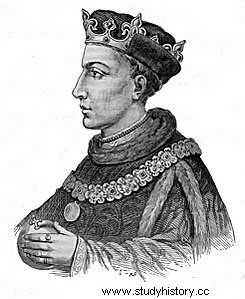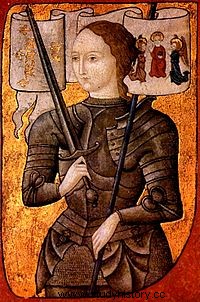
Entry taken from the book The Plantagenets
Henry VI is a unique case in history. He was the only person ever to be simultaneously crowned King of England and King of France. However, his coronation had to be organized in a hurry, neither in one place nor in the other did he rule peacefully, he ended up losing both crowns and died in suspicious circumstances when he was imprisoned in the Tower of London.
Henry VI was born on December 6, 1421 at Windsor Castle. His father was King Henry V of England and his mother was French Princess Catherine of Valois. The outlook for the couple when his son was born could not be more rosy:Henry V had dealt a fatal blow to the French enemy in the Hundred Years' War with his resounding victory at the Battle of Agincourt (1415). From that moment on, he had roamed freely through French territory until King Charles VI (nicknamed the Beloved, but also the Madman for his periodic episodes of dementia that made him incapable of governing) ended up signing the Treaty of Troyes in 1420 by the one that recognized Henry V as heir to the French throne and granted him the hand of his daughter Catherine of Valois.
The treaty was ratified by the French Parliament, which also removed the Dauphin Charles from the succession, implicated in the obscure murder of the Duke of Burgundy. All the English king had to do was return to his country and wait for the unstable French monarch to die. The fact that Catherine quickly gave him a son and that he was a boy, only ratified the brilliant panorama that awaited the English monarchy. But in 1422 Henry V had to return to France to face a rebellion, forcing him into a long and unhealthy siege of the city of Meaux, where he fell ill and died at Vincennes on August 31, 1422.

The death of Henry V was a complete turnaround for the glorious situation that was presented for English interests. The warrior hero of Agincourt had been designated heir to the French Crown and was in a position to make a dream come true that not even the initiator of the Hundred Years' War, Edward III, had believed possible:to unify the Crowns of France under his command. France and England and start a new era for both countries.
His untimely death nullified all these ambitious projects, and the fact that he had only had time to father a son and that he was not even a year old when his father died, represented a very serious brake on the English aspirations over France, where there had been a clear division marked by the border of the Loire river, between the north of the country, dominated by England with the support of the duchy of Burgundy, and the south, in which the dauphin's followers had appointed him as successor to his father and king with the name of Carlos VII. The first military action after the death of Henry V took place in 1428 when the Duke of Bedford laid siege to the city of Orleans.
In the area of France dominated by the English, a good part of the French inhabitants did not fully recognize the subjection to the King of England. For them, the feelings towards the neighbors on the other side of the Canal ranged from considering them as invaders to hating them. This led to the proliferation of acts of hostility on the French side and harsh repression on the English side.
The Siege of Orleans had begun with good news for the French when the Earl of Salisbury was killed early in the fighting. But reinforcements had arrived for the besiegers and an attempt to liberate the city on February 12, 1429 failed in the so-called herring day . The city's demoralized garrison offered to surrender to the Duke of Burgundy, but the Duke of Bedford refused the offer. The Burgundian contingent withdrew from the siege, but the English held it.
For the French king, the liberation of the city had become an obsession. It was then that a seventeen-year-old girl, Joan of Arc, appeared at the court of Charles VII in Chinon at the end of February or beginning of March 1429, stating that God had appeared to her ordering her to lead the French armies to victory against France. England. In her vision she had the dual task of lifting the siege of Orleans and having the true King of France crowned at Reims. Whether it was because they surrendered to her mystical speech, or because they considered her useful for their purposes, the fact is that the king and his advisers decided to provide the young woman with an army, a horse and armor and sent her to lift the siege of Orleans.

Before entering the campaign, the young woman sent a challenge to the English in which he ordered them to return France in the name of the "King of Heaven". Her arrival in Orleans took place on April 29. In the following days more French reinforcements arrived, encouraging the townspeople to attempt a breakout. On May 8, after three of its fortifications had been taken by the French, the British lifted the siege.
Encouraged by the news, Charles broke through the English lines, defeated the enemy at the Battle of Patay on June 18, and advanced to take Reims, the traditional coronation site of kings of France, where her ceremony was held on July 17, 1429. The double task of Joan of Arc's vision was complete.
The intention of the Council of the Realm in England was that the coronation of Henry VI as king would take place once he had reached the age of fourteen. But the situation in France created as a result of the role played by Joan of Arc meant that the decision had to be changed hastily. On November 5, 1429, he was crowned King of England at Westminster. And plans were made for his coronation ceremony to be held as King of France in Reims.
But the military situation on the continent did not make it easy to fulfill these plans. It was not until December 1431 that Henry VI was crowned King of France, not in Reims but in Paris. Curiously, it was this fact, which meant that for the first time the same monarch had been crowned both in Westminster and in Nôtre Dame and, therefore, as king of England and France simultaneously, which marked the beginning of the decline of English rule on the continent. . The Duchy of Burgundy abandoned its alliance with England, and while the three English regents (the Duke of Bedford, the Earl of Gloucester, and Cardinal Beaufort) disagreed on policy, multi-party peace talks took place at Arras in 1435. which ended without agreement between the French and English. Things got worse in September of that year when, as a result of the Arras treaty, the alliance between France and Burgundy was formalized and when the Duke of Bedford died.
The rest of Henry VI's reign would be marked by trouble both in France and in England, where he would die (possibly assassinated) in 1471 while held captive in the Tower of London... but that is another story, part of it told in the entries dedicated to the Treaty of Tours and the reign of Edward IV of England.
Images| Wikimedia commons
Dan Jones. Plantagenets, The Kings Who Made England. London, Ed. William Collins, 2012.
Peter Ackroyd. A History of England. Volume I (Foundations). London, Ed. McMillan, 2011.
Roy Strong. The Story of Britain. London, Pimlico Ed., 1998.
Simon Schama. A History of Britain . London, BBC Worldwide Limited, 2000.
Derek Wilson. The Plantagenets, The Kings That Made Britain . Ebook edition, London, Quercus Edition Ltd., 2014.
